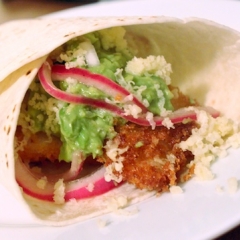What Is Tilapia?
Tilapia is the new "chicken of the sea." With the widespread worries about mercury contamination, tuna is out, and tilapia is in. It's a versatile and budget-friendly alternative that is open to a variety of preparations, including sautéing, grilling, baking, broiling, poaching, frying, and steaming.  You can even find it raw — it's known as "izumidai" in sushi bars, although it might be a bit tough to find in that form. (Photo courtesy of Yasmin Fahr)
You can even find it raw — it's known as "izumidai" in sushi bars, although it might be a bit tough to find in that form. (Photo courtesy of Yasmin Fahr)
Originally found in North Africa, this freshwater white-fleshed fish has taken well to farming, especially because it is a sustainable source of protein when raised responsibly; tilapia yields more protein than it consumes. According to the Monterey Bay Aquarium Seafood Watch, the most environmentally friendly choice is U.S. farmed tilapia, although it might be a tough find since only a small fraction of the tilapia eaten in the U.S. is actually grown here. Fish from Brazil, Costa Rica, Ecuador, and Honduras are also good alternatives. Farmed tilapia from China and Taiwan are on the "no-go" list since there are usually issues with water contamination.
It is most often sold filleted, but visit the local fishmonger (if you are lucky enough to have one) or an Asian grocery store and you may be able to find them whole, perhaps even live. If purchasing whole tilapia, as with any whole fish, look for clear, intact eyes, firm flesh, and bright red gills. Avoid those with milky or opaque eyes; a fishy smell; soft, watery flesh; and dull-colored gills.
 With its clean, slightly sweet flavor, tilapia is a blank slate that will let you get creative and can take on the flavor of whatever sauce, salsa, rub, or marinade you concoct. Try making curry, tacos, and even casseroles. Who knows? It might even convince the "I only eat chicken" crowd to do a little more than just push flakes of fish around on the plate. (Photo courtesy of Maryse Chevriere)
With its clean, slightly sweet flavor, tilapia is a blank slate that will let you get creative and can take on the flavor of whatever sauce, salsa, rub, or marinade you concoct. Try making curry, tacos, and even casseroles. Who knows? It might even convince the "I only eat chicken" crowd to do a little more than just push flakes of fish around on the plate. (Photo courtesy of Maryse Chevriere)